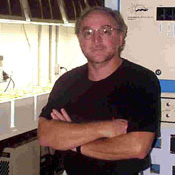Tom Rufty
Professor
Bayer Distinguished Professor of Sustainability
Crop and Soil Science Department, NC State
Bio
Research:
- Plant and plant community interactions with the environment
- Physiological and genetic factors controlling plant responses
- Experimentation with crop, weed and invasive species
Publications
- Evaluating Bacterial Nanocellulose Interfaces for Recording Surface Biopotentials from Plants , SENSORS (2024)
- Comment on ?Soybean photosynthesis and crop yield are improved by accelerating recovery from photoprotection? , SCIENCE (2023)
- Bringing Skepticism to Crop Science , SpringerBriefs in Agriculture (2022)
- Real-Time Monitoring of Plant Stalk Growth Using a Flexible Printed Circuit Board Sensor , 2022 IEEE SENSORS (2022)
- Leaf expansion and recovery from soil drying in soybean genotypes , JOURNAL OF CROP IMPROVEMENT (2020)
- Predominant Microbial Colonizers in the Root Endosphere and Rhizosphere of Turfgrass Systems: Pseudomonas veronii, Janthinobacterium lividum, and Pseudogymnoascus spp. , FRONTIERS IN MICROBIOLOGY (2021)
- "Cycling of amino-nitrogen and other nutrients between shoots and roots in cereals-A possible mechanism integrating shoot and root in the regulation of nutrient uptake" by HD Cooper and DT Clarkson, Journal of Experimental Botany (1989) 40:753-762 , CROP SCIENCE (2020)
- Leaf gas exchange recovery of soybean from water-deficit stress , Journal of Crop Improvement (2020)
- Soil microbial diversity and composition: Links to soil texture and associated properties , SOIL BIOLOGY & BIOCHEMISTRY (2020)
- Increasing Photosynthesis: Unlikely Solution For World Food Problem , TRENDS IN PLANT SCIENCE (2019)
Grants
During the period of active growth, plants are subjected to varying environmental conditions which prevent the plant from maintaining its maximum potential for growth and survival. In the turf-grass industry in particular, turf-grasses must endure periods of both biotic and abiotic stress. It is the intention of this testing that the parameters best signifying the stress are identified and are scientifically evaluated against novel treatments or combinations of treatments to aid the plant to withstand the effects of such stress, thus improving plant health and quality.
To begin exploring and evaluating the impact of PRB33+ on turf grass performance and stress tolerance
The United Soybean Board has funded a continuing project on the development of drought resistant soybean for the past 20 years. One product from this effort is the new drought resistant variety USDA N8002, just released by the USDA soybean breeding program in North Carolina. In 2016, we initiated a project to examine drought resistance in commercial soybean cultivars. More than 100 commercial varieties extending from maturity group V through VIII were evaluated for drought response at the Sandhills Research Station in NC and compared to new drought resistant products developed by the public sector. In August, an intense drought developed at the Sandhills station and commercial cultivars were successfully evaluated for drought response in replicated trials. Results indicated that although many commercial cultivars are drought sensitive, some possess a slow-wilting trait indicative of drought resistance. Yield assessment will be completed this fall. The current funding request is to continue this evaluation for a second year at the Sandhills Research Station. The assessment of commercial cultivars will determine which commercial programs may be using publicly developed drought resistant materials as parental stocks, and which programs need to. We will use this information to target outreach programs to transfer this technology from the public to the private sector.
Drought is one of the major problems for soybean farmers in North Carolina. As research plant physiologists, we are identifying genetic traits that are used by plant breeders to increase drought tolerance of new cultivars. In this project, we will study soybean recovery from periods of drought, a key for maintaining high soybean yields. Preliminary research indicates that large genetic differences exist in the ability to recover high leaf expansion rates and nitrogen fixation. The favorable recovery traits will provide a unique advantage for new cultivars during periods without adequate rainfall. Funding will support the assistantship of a new Ph.D student who has just joined our soybean research program.
The objective is to develop high yielding drought tolerant cultivars adapted to North Carolina and other drought-prone US environments. A broad range of soybean germplasm will be compared for water use efficiency, drought tolerant nitrogen fixation, and stomatal response to drying air. Complementing greenhouse and field experiments will be conducted to examine these traits.
